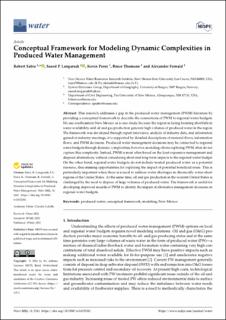| dc.contributor.author | Sabie, Robert | |
| dc.contributor.author | Langarudi, Saeed Pourmasoumi | |
| dc.contributor.author | Perez, Kevin | |
| dc.contributor.author | Thomson, Bruce | |
| dc.contributor.author | Fernald, Alexander | |
| dc.date.accessioned | 2023-03-28T13:04:38Z | |
| dc.date.available | 2023-03-28T13:04:38Z | |
| dc.date.created | 2022-09-21T17:28:36Z | |
| dc.date.issued | 2022 | |
| dc.identifier.issn | 2073-4441 | |
| dc.identifier.uri | https://hdl.handle.net/11250/3060761 | |
| dc.description.abstract | This research addresses a gap in the produced water management (PWM) literature by providing a conceptual framework to describe the connections of PWM to regional water budgets. We use southeastern New Mexico as a case study, because the region is facing looming shortfalls in water availability, and oil and gas production generate high volumes of produced water in the region. The framework was developed through expert interviews, analysis of industry data, and information gained at industry meetings; it is supported by detailed descriptions of material flows, information flows, and PWM decisions. Produced water management decisions may be connected to regional water budgets through dynamic complexities; however, modeling efforts exploring PWM often do not capture this complexity. Instead, PWM is most often based on the least expensive management and disposal alternatives, without considering short and long-term impacts to the regional water budget. On the other hand, regional water budgets do not include treated produced water as a potential resource, thus missing opportunities for exploring the impact of potential beneficial reuse. This is particularly important when there is a need to address water shortages in chronically water-short regions of the United States. At the same time, oil and gas production in the western United States is challenged by the need to dispose of large volumes of produced water. The framework is useful for developing improved models of PWM to identify the impact of alternative management decisions on regional water budgets. | en_US |
| dc.language.iso | eng | en_US |
| dc.publisher | MDPI | en_US |
| dc.rights | Navngivelse 4.0 Internasjonal | * |
| dc.rights.uri | http://creativecommons.org/licenses/by/4.0/deed.no | * |
| dc.title | Conceptual Framework for Modeling Dynamic Complexities in Produced Water Management | en_US |
| dc.type | Journal article | en_US |
| dc.type | Peer reviewed | en_US |
| dc.description.version | publishedVersion | en_US |
| dc.rights.holder | Copyright 2022 The Author(s) | en_US |
| dc.source.articlenumber | 2341 | en_US |
| cristin.ispublished | true | |
| cristin.fulltext | original | |
| cristin.qualitycode | 1 | |
| dc.identifier.doi | 10.3390/w14152341 | |
| dc.identifier.cristin | 2054087 | |
| dc.source.journal | Water | en_US |
| dc.identifier.citation | Water. 2022, 14 (15), 2341. | en_US |
| dc.source.volume | 14 | en_US |
| dc.source.issue | 15 | en_US |

